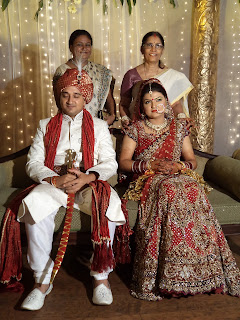Jammu population is composed of Hindus, Muslims and Sikhs. Majority were Hindus. There are three types of Hindus: Dogra, Rajputian and Kashmiri. Dogra consists of Brahman, Mahajan, Sharma, Gupta, Khajuria and many more. Mahajan is a category of Hindus who are rich. Rajputs are Kshatriyas, the fighting community. Chibs, Manhas, Jamwals, Mankotiyas, and many more are Rajputs. The Kashmiris are like Raina, Koul, Bhat, Pandita, Ganjoo.
In marriage, gold ornaments are given from the bride's side and from the side of the groom. However, unlike in Kerala, the bride gets more gold ornaments from the groom's side in a Kashmiri wedding. The bride receives dresses from both the parties. The bride takes gifts like sarees, handbags, cash etc. to the groom's parents and close relatives. 'Matyamoor' is the name given to the gift which is given by the mother in law to the bride when she sees the bride for the first time. The daughter in law also gives gift to the mother in law. Groom's maternal and paternal relatives give ornaments and cash to the bride. A huge crowd consisting of relatives and friends attend the wedding. It is celebrated as a festival in Jammu.
Rajputian wedding:
Traditionally, the wedding celebration starts a week before. Now a days, it is reduced to 3 days. The morning of the first day starts with Sangeet (music) participated by women. They love this event. All types of funny songs are sung in groups using different kinds of orchesra. In the after noon, a traditional lunch is served. Ambal curry made of pumpkin, Rajma dal, vegetable curries are served with sweet dishes. In the evening, the bride's hands and feet were beautifully decorated with mehandi. It will take 3 to 4 hours to finish this event. the decoration is done in the house and several of the brides' friends and relativeswill be with the bride. The next day's performance was saant. It is a ritual of purifying the bride with water and curd by uncle and aunt. After purifivation, the bride was escorted to agnikudu.The panditji was reciting mantras and later, the maternal uncle puts bangles called Chuda and Nathini, a very big ring is put on the left nose. Kalerins are the hangings made of dry fruits and coconuts and they are tied on chooda by the relatives. Then, Kyur, a sweet dish is given to the bride. The groom comes in the same evening to the bride's house. Pancharti( covered with 5 lamps) is brought by bride's mother and the lamp is circled on the bride groom three times. The Mother also does abhishek and put tilak on his fore head, garlands him and welcomes him. The fathers from both the sides greet each other, garland each other and exchange gifts, and same is done by the relatives too. All of them are recieved to the marriage hall. The groom sits on the chair on the stage. The bride is brought by her friendsto the stage. bride and the groom garland each other (known as jaimala). Thay are moved to mandap. A funny game called stealing shoes is played by their friends and cousins. The moment the groom takes off his shoes, the bride's sisters attempts to snatch the shoes from him. At the same time, the groom's brothers try to prevent them from taking off his shoes. If the shoes are snatched, they hide them till the marriage ceremony is over. The groom begs for his shoes and pays a penalty to get back his shoes. He will loose Rs. 1000 to 10, 000! If the girls fail to take off his shoes, no penalty for girls. It is said that this game is very popular in north indian marriages. The marriage function continues through out the night. The food consists of variety of soups, coffee and tea, soft drinks, different kinds of ice creams, halva pudi ( sweet dish), channa pudi, pulauv- non sweet and sweet, rice, different types of vegetable curries, dal curries, nan, parattas, chappati, sarson ka saag( a type of green leaf vegetable curry) with makki ki roti(chappati made of corn flour), chappati made of rice flour called dosha, pizza, mommos( chines dishes) and noodles, pani puri, alu ki tikki, and several such tasty dishes! One can not eat all these dishes in a day! But, there are many choices so that people could really enjoy the feast. The third day is vidai means telling good bye to the bride. It is a painful day for the parents, relatives and friends of the bride. All these events happened in the wedding of coral.
Coral looked exceedingly beautiful in her traditional Rajputian wedding suit. Vishal looked stunnigly handsome. One of the main reasons to visit Jammu was to attend her wedding. Did I think it would happen when I promised her with my presence? I wished I could attend her wedding. I never thought it would be possible because the wedding was in Jammu and I was in Kerala. I will never forget October 12 & 13. I was physically not at all in a good condition on October 12. The residual pain from Vaishno Devi temple visit was pronounced on my body. But my mind was filled with bliss. I wanted to be with Coral from the morning of 12th itself. But I was in so much of pain that I could not attend the previous day's events.
Music and food were the main menu. All enjoyed the wedding very much. The bridegroom arrived in a charriot. Youngsters were singing and dancing. I could see many people giving presents to her.
Just imagine how many hours the bride and the bride groom had to sit on the stage! But for them it is an acceptable ritual. For me, it was a very good learning. I was able to understand the north Indian(Rajputian) wedding. Thanks to Coral's family. Thanks to prerna ganjoo who explained the rituals of a jammu wedding.




Hope you have enjoyed the marriage...
ReplyDelete